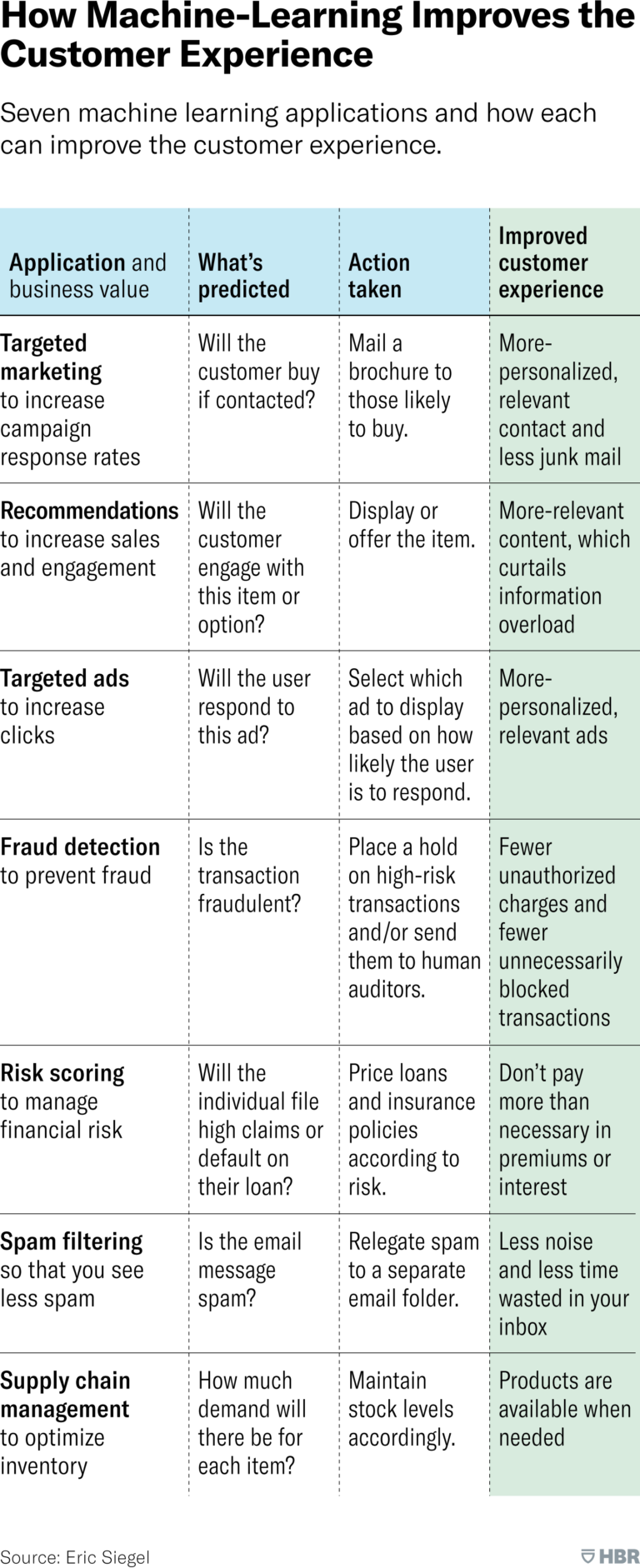How Machine Learning can improve customer experience
The world largely focuses on how advanced and impressive the core technology is, which distracts from focusing intensely on its tangible value proposition, the precise ways in which it can render business processes more effective.

Machine learning is a promising technology for improving the customer experience. Why? It’s simple: because it can predict customer behaviors. Prediction as a capability is the Holy Grail for foreseeing each customer need and personalizing products and services accordingly. From the consumer’s perspective, when ML’s ethical pitfalls are avoided, prediction can be the ultimate antidote to the information overload that we all face every day. By deploying ML to predict which content is most relevant for each individual, customers can receive better recommendations, less junk mail, very little inbox spam, and higher quality search results, among many other things. These improvements to customer experience aren’t only a nice-to-have, pleasant side-effect of profit-driven ML deployments. They pursue the raison d’etre of any company — to serve customers — and will ultimately translate into further benefits for the business. After all, a happier customer is a more loyal customer, and a higher customer retention rate means a higher customer growth rate.
Machine learning (ML) — technology that learns from experience (data) to predict the behavior of each individual — is well known for improving the bottom line by running major operations more effectively. But did you know that it can also measurably improve the customer experience?
ML generates actionable predictions for individual customers, and those predictions can drive how each customer is served. In this way, ML can target a marketing campaign to customers who are more likely to respond, or disallow credit card transactions that are likely to be fraudulent. It can move likely spam out of the email inbox, or display the property (Airbnb), search result (Google), product (Amazon and Netflix), or romantic partner (Match.com) that’s most likely to be of interest to a customer.
Despite these clear value propositions, ML isn’t yet deployed nearly as widely and seamlessly as it could be. The problem is that the world largely focuses on how advanced and impressive the core technology is, which distracts from focusing intensely on its tangible value proposition — the precise ways in which it can render business processes more effective. As a result, most ML projects fail to deploy, never realizing their intended business value. But as decision makers increasingly recognize that ML can have a huge impact on the customer experience — in addition to the bottom line — companies will begin to shift their focus to generating concrete value with ML, ultimately accelerating and expanding its use.
How ML Helps to Improve the Customer Experience
Why is ML such a promising technology for improving the customer experience? It’s simple: It can predict customer behaviors. Prediction as a capability is the Holy Grail for foreseeing each customer need and personalizing products and services accordingly. From the consumer’s perspective, when ML’s ethical pitfalls are avoided, prediction can be the ultimate antidote to the information overload that we all face every day. By deploying ML to predict which content is most relevant for each individual, customers can receive better recommendations, less junk mail, very little inbox spam, and higher quality search results, among other things.
This has far-reaching potential. ML’s predictions can enhance the customer experience across lines of business and across industries. By way of illustration, here are seven established business applications of ML, each delivering an impact to the bottom line (the leftmost column) — as well as an impact to the customer experience (the rightmost column):

Customers Clamor for Fraud Detection
In one of these arenas — fraud detection — customers already clamor for ML’s predictions. In fact, they complain loudly when prediction fails them. Failure comes in two flavors. For one, if you as a customer see an unexpected charge on your credit card bill, you’ll probably get a bit irritated. And yet, when using your credit card, if a charge won’t go through because your bank’s system thinks it could be unauthorized, you might get irritated just the same.
The only way to maximize the customer experience is to minimize those two kinds of mispredictions — and that’s where ML comes in. ML is the science of improving prediction by way of learning from data. That’s its very definition.
In the prevention of card fraud, FICO is the leader. Their Falcon product, used by 9,000 banks, screens all of the transactions made with most of the world’s credit and ATM cards — 2.6 billion cards globally. By detecting fraud with ML, a medium-sized bank could save about $16 million and, at the same time, improve the customer experience by decreasing the fraud its cardholders experience by about 60,000 cases (see the back-of-a-napkin arithmetic here). I consider Falcon one of the world’s most successful and widely impactful commercial deployments of ML.
This operation mostly goes unseen, but such unseen efficiencies often do more for the customer experience than the predictive operations that garner the most attention. FICO Falcon affects each consumer much more frequently than the most famous ML system, one that’s commonly known among consumers: the FICO Credit Score, a household name and a major factor in your power to borrow. Many understandably feel that their FICO Score is an important part of their identity as a consumer. Meanwhile, although Falcon’s fraud detection is normally invisible to consumers, it affects their experience much more often: every time they use their card. FICO evaluates financial power by day and fights financial crime by night.
Help Me to Help You: Creating a Virtuous Cycle
Plenty of other proven ML applications that serve the bottom line also serve the customer experience, including the use of ML to route customer service calls, streamline support ticket flow, and detect other kinds of malicious behavior beyond fraud, including phishing, misinformation, and offensive content.
Of course, by helping the customer, companies also help themselves. These improvements to customer experience aren’t only a nice-to-have, pleasant side-effect of profit-driven ML deployments. They pursue the raison d’etre of the company — to serve customers — and will ultimately translate into further benefits for the business. After all, a happier customer is a more loyal customer, and a higher customer retention rate means a higher customer growth rate. The sooner you deploy ML to serve these dual purposes, improving both the bottom line and the customer experience, the sooner your firm can begin to capitalize on this virtuous cycle.
***
Alessio De Filippis, Founder and Chief Executive Officer @ Libentium.
Founder and Partner of Libentium, developing projects mainly focused on Marketing and Sales innovations for different types of organizations (Multinationals, SMEs, startups).
Cross-industry experience: Media, TLC, Oil & Gas, Leisure & Travel, Biotech, ICT.











